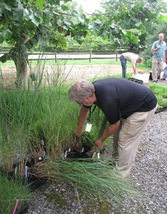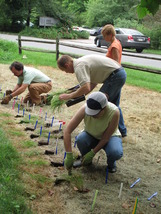Native plants added to Brandywine Museum site
07/24/2013 04:03PM ● By Acl
Mark Gormel (left), the horticultural coordinator for the Brandywine Conservancy, oversees the removal of the landscape plugs.
By John Chambless
Staff Writer
Nature really does know best, but sometimes nature just needs a little help getting started.
That's what volunteers and Brandywine Conservancy employees were doing on Tuesday morning as they planted native grasses and flowers on a strip of land along the entrance to the Brandywine River Museum.

Several areas adjacent to the Environmental Management Center have been cleared of grass and are being planted with a variety of species that will eliminate the cost of mowing and maintaining the grass, and expand the habitat for insects and wildlife that is already flourishing in the nearby parking lot of the museum in Chadds Ford.
More than 5,000 "landscape plugs" have been grown locally and purchased, and the first of them were put in the ground on Tuesday morning. The planting will continue July 24 and 25.
In three areas of former turf grass, there will be more than 50 different species, including those that grow well in moist to dry soil in full sun, to those that grow well in moist to wet soil in full shade. The plantings will strengthen the ecological health of the Chadds Ford campus with what will become a habitat for birds, bees and butterflies.
The plantings will also reduce storm water runoff and improve the quality of water in the Brandywine, and will lower the facility's carbon footprint by reducing the amount of turf grass that is regularly mowed. All the species are native to the eastern mid-Atlantic area.
One low-lying area near the Environmental Management Center is chronically marshy, but new plantings will soak up excess water and expand the habitat.
On Tuesday morning, the area to be planted was staked with color-coded plastic knives that

indicated where the various varieties of plants should go. Some volunteers took the plants out of their plastic containers while others dug down into the soft ground and patted the plants into place.
Native grasses will include Big Bluestem, Switchgrass, Indian grass, Little Bluestem Grass, Purple Love grass and Tufted Hair grass. Species with flowers include those that bloom early in spring, like Marsh Marigold, Prairie Phlox and Golden Ragwort; those that bloom in summer, like Culver's Root, Butterfly Milkweed, Bee-Balm and Threadleaf Coreopsis; and those that bloom in fall, such as Smooth Aster, Slender Goldentop, Gray-headed Coneflower and Autumn Alumroot. Switchgrass has roots that can reach 10 feet deep, providing high drought tolerance, and allowing storm water to more easily infiltrate the soil.


